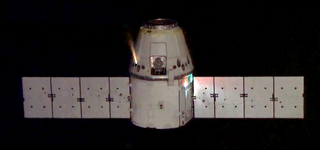
A nuclear thermal rocket (NTR) is a type of thermal rocket where the heat from a nuclear reaction replaces the chemical energy of the propellants in a chemical rocket. In an NTR, a working fluid, usually liquid hydrogen, is heated to a high temperature in a nuclear reactor and then expands through a rocket nozzle to create thrust. The external nuclear heat source theoretically allows a higher effective exhaust velocity and is expected to double or triple payload capacity compared to chemical propellants that store energy internally.

A hypergolic propellant is a rocket propellant combination used in a rocket engine, whose components spontaneously ignite when they come into contact with each other.

A liquid-propellant rocket or liquid rocket utilizes a rocket engine burning liquid propellants. (Alternate approaches use gaseous or solid propellants.) Liquids are desirable propellants because they have reasonably high density and their combustion products have high specific impulse (Isp). This allows the volume of the propellant tanks to be relatively low.

Space Exploration Technologies Corporation, commonly referred to as SpaceX, is an American spacecraft manufacturer, launch service provider, defense contractor and satellite communications company headquartered in Hawthorne, California. The company was founded in 2002 by Elon Musk with the goal of reducing space transportation costs and ultimately developing a sustainable colony on Mars. The company currently produces and operates the Falcon 9 and Falcon Heavy rockets along with the Dragon and Starship spacecraft.

Merlin is a family of rocket engines developed by SpaceX for use on its Falcon 1, Falcon 9 and Falcon Heavy launch vehicles. Merlin engines use RP-1 and liquid oxygen as rocket propellants in a gas-generator power cycle. The Merlin engine was originally designed for sea recovery and reuse, but since 2016 the entire Falcon 9 booster is recovered for reuse by landing vertically on a landing pad using one of its nine Merlin engines.

The staged combustion cycle is a power cycle of a bipropellant rocket engine. In the staged combustion cycle, propellant flows through multiple combustion chambers, and is thus combusted in stages. The main advantage relative to other rocket engine power cycles is high fuel efficiency, measured through specific impulse, while its main disadvantage is engineering complexity.

Spacecraft electric propulsion is a type of spacecraft propulsion technique that uses electrostatic or electromagnetic fields to accelerate mass to high speed and thus generating thrust to modify the velocity of a spacecraft in orbit. The propulsion system is controlled by power electronics.

The pintle injector is a type of propellant injector for a bipropellant rocket engine. Like any other injector, its purpose is to ensure appropriate flow rate and intermixing of the propellants as they are forcibly injected under high pressure into the combustion chamber, so that an efficient and controlled combustion process can happen.

The SpaceX Draco is a hypergolic liquid rocket engine designed and built by SpaceX for use in their space capsules. Two engine types have been built to date: Draco and SuperDraco.

The TR-106 or low-cost pintle engine (LCPE) was a developmental rocket engine designed by TRW under the Space Launch Initiative to reduce the cost of launch services and space flight. Operating on LOX/LH2 the engine had a thrust of 2892 kN, or 650,000 pounds, making it one of the most powerful engines ever constructed.
The TR-107 was a developmental rocket engine designed in 2002 by Northrop Grumman for the NASA and DoD-funded Space Launch Initiative. Operating on LOX/RP-1, the engine was throttleable and had a thrust of 4,900 kN (1,100,000 lbf) at a chamber pressure of 17.7 megapascals (177 bar), making it one of the most powerful engines ever constructed.

Since the founding of SpaceX in 2002, the company has developed four families of rocket engines — Merlin, Kestrel, Draco and SuperDraco — and is currently developing another rocket engine: Raptor, and after 2020, a new line of methalox thrusters.

SpaceX has stated its ambition to facilitate the colonization of Mars via the development of the Starship launch vehicle. The company states that this is necessary for the long-term survival of the human species and for the expansion of the scope of human consciousness.

The Dragon 2 DragonFly was a prototype suborbital rocket-powered test vehicle for a propulsively-landed version of the SpaceX Dragon 2. DragonFly underwent testing in Texas at the McGregor Rocket Test Facility in October 2015. However, the development eventually ceased as the verification burden imposed by NASA was too great to justify it.

SuperDraco is a hypergolic propellant rocket engine designed and built by SpaceX. It is part of the SpaceX Draco family of rocket engines. A redundant array of eight SuperDraco engines provides fault-tolerant propulsion for use as a launch escape system for the SpaceX Dragon 2, a passenger-carrying space capsule.

A liquid apogee engine (LAE), or apogee engine, refers to a type of chemical rocket engine typically used as the main engine in a spacecraft.

This is a corporate history of SpaceX, an American aerospace manufacturer and spacetransport services company founded by Elon Musk.

Raptor is a family of rocket engines developed and manufactured by SpaceX. The engine is a full-flow staged combustion cycle (FFSC) engine powered by cryogenic liquid methane and liquid oxygen ("methalox").
Impulse Space was founded in 2021 by Tom Mueller, employee No.1 at SpaceX and engineer of the Merlin and Draco rocket engines that power the Falcon 9 and Dragon spacecraft. The company develops in-space transportation services for satellites that fly to Low Earth Orbit then need to reach other orbits.
Before settling on the 2018 Starship design, SpaceX successively presented a number of reusable super-heavy lift vehicle proposals. These preliminary spacecraft designs were known under various names.


















